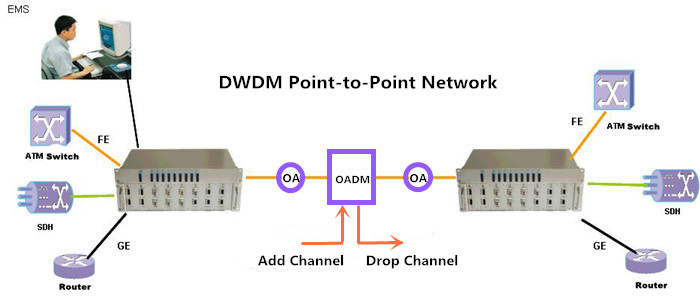Although optical parallel transmission is direct, simple and effective to transmit big data, it is not very recommendable as its cabling cost would be very high for the multiple optical lanes. Then what should we do when we need high capacity network for big data transmission? In this post, it is highly recommended to utilize SWDM (shortwave wavelength division multiplexing) technology as a cost effective solution that offers each fiber at least four times higher capacity for meeting our needs. As shown in the following figure, SWDM technology can multiplex at least four short wavelengths in the 850-950nm range over a single strand of duplex OM5 fiber, so that more than four virtual lanes can be created for optical transmission.
Benefits of SWDM Technology Over OM5 Fiber
Undoubtedly, SWDM technology is a cost effective solution for 40G, 100G or even higher connectivity over duplex multimode fiber, especially OM5. With regard to the benefits of SWDM technology, it is shown below:
Transmission Distance–When using SWDM technology for 40G connectivity over OM5 fiber, the transmission distance can be up to 440 m; for 100G connectivity, the transmission distance can be 200 m at most. Besides, SWDM technology can also support 40G connectivity over OM3 and OM4 at lengths up to 250 m and 350m, respectively.
Excellent Design–Firstly, the Full DDM enables five digital diagnostics functions, temperature, voltage, bias current, Rx power, and Tx power. Secondly, the single Tx and Rx ports enable easier operation and measurement. Thirdly, the simple Tx and Rx port design also makes network security appliances easy and fast.
Power Dissipation–Compared to SR4 optic, the SWDM optic has a lower power dissipation for matching the 4x WDM optical architecture with 4x electrical interface. In general, the power dissipation of QSFP+ SWDM4 can be as low as 1.5W, so that QSFP+ SWDM4 can be also used in the applications with QSFP+ SR4 standard.
40G SWDM4 vs 100G SWDM4 vs 100G SWDM2
With the introduction of OM5 fiber, the multimode fiber cabling system becomes much more popular than ever before. To meet the multimode fiber cabling system needs, multimode SWDM transceiver series including 40G SWDM4, 100G SWDM4 and 100G SWDM2 were published in succession, which are less expensive but have more efficient power consumption, compared to singlemode transceivers.
40G SWDM4–It is a typical kind of QSFP+ transceiver, designed with duplex connector, which always works with duplex-LC OM5 fiber. Since SWDM technology is used in this kind of QSFP+ transceiver, a 40G connectivity can be easily achieved with the use of a pair of 40G SWDM4 transceivers and a length of duplex-LC OM5 fiber cable. When the 40G connectivity is working, four 10G signals with different wavelengths (850nm, 880nm, 910nm and 940nm) are multiplexed at the transmitter end, transmitted through the OM5 fiber cable and finally demultiplexed at the receiver end, as shown in the following figure.
100G SWDM4–It is a QSFP28 standard transceiver with duplex connector used for 100G connectivity. Its working principle is very similar to 40G SWDM4 that can be easily learned from the figure below. In simple words, the total 100G connectivity is done by multiplexing four 25G signals with the same four wavelengths (850nm, 880nm, 910nm and 940nm) over duplex -LC OM5 fiber cable.
100G SWDM2–Compared to 100G SWDM4, the 100G SWDM2 transceiver has a easier working principle which only multiplexes two different wavelengths (850nm and 910nm) for carrying two 50G signals over the duplex -LC OM5 fiber cable. Hence, a 100G connectivity can be totally reached.
Uncertainty of SWDM Technology Over OM5 Fiber
Although the SWDM technology over OM5 fiber brings us so many benefits, there are still some uncertain factors existing that prevent the SWDM technology from being widely adopted. Above all, the SWDM technology is not mature enough to support our needs at present. The factors including SWDM transceiver complexity, the power consumption and the total cabling cost using SWDM technology are the potential obstacles. Meanwhile, the SWDM connectivity is not so flexible as the parallel connectivity and can’t support breakout configuration in the short-reach cabling systems. Once these uncertainty are solved, the SWDM technology will be more and more mature for widely use.

























